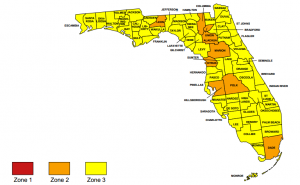Florida is actually one of the few states in the country that requires schools and child care centers to test for radon. In addition, 24-hour care facilities such as nursing homes, prisons and even foster homes must also be tested for the deadly gas.
Building purchase contracts and rental agreements must mention that elevated radon levels have been found in the state of Florida – hopefully making more homeowners and renters aware of the problem.
Radon is a Problem in Florida
 Believe it or not, several counties in the state are more susceptible to radon primarily due to the abundance of rocky or clay-like soils that are rich in uranium. The element actually decays, producing a radioactive gas known as radon – which is odorless, colorless and tasteless. The gas can quietly seep into the cracks of a homes foundation, windows or walls and collect in great amounts. It can also enter a home through unfiltered well water – although in much lesser quantities usually. That being said, no matter how it enters the home, if left untreated it can build up significantly creating a toxic environment. In many cases, homeowners have no idea they are basting in a toxic home putting their entire family in danger.
Believe it or not, several counties in the state are more susceptible to radon primarily due to the abundance of rocky or clay-like soils that are rich in uranium. The element actually decays, producing a radioactive gas known as radon – which is odorless, colorless and tasteless. The gas can quietly seep into the cracks of a homes foundation, windows or walls and collect in great amounts. It can also enter a home through unfiltered well water – although in much lesser quantities usually. That being said, no matter how it enters the home, if left untreated it can build up significantly creating a toxic environment. In many cases, homeowners have no idea they are basting in a toxic home putting their entire family in danger.
Homeowner Larry Condra had a mitigation installed in his home after the levels were found to be about 7 pCi/L, well over the recommended action limit of 4.0pCi/L as set by the US EPA. After the system was installed, levels in his home reduced to 0.4 pCi/L.
“It cost me around $1,900, but it’s well worth it rather than sitting around wondering whether there’s some kind of radioactive isotope going down into my lungs that’s going to give me lung cancer somewhere down the road.”
Condra tested his home after researching about a family’s member’s thyroid cancer and finding the relation between high levels of radon and an increased risk of cancer. Although, the most common type of cancer associated with radon is lung cancer, but that’s not to say those who are exposed can’t be affected by other types.
A friend of Condra’s also had her home tested, which happened to measure in excess of 30 pCi/L.
“She said that’s really weird because you spend your whole life trying to eat right, exercise, don’t do anything unhealthy and you’re sitting in a house that’s toxic, literally.”
Florida Counties with a High Risk for Radon
According to the US Environmental Protection Agency, there are nine counties in the state of Florida that exhibit a high risk for radon, or more specifically elevated indoor levels of the deadly gas. The average screening for the areas is about 2 pCi/L to 4 pCi/L, which is relatively high and indicates a potential abundance of radon.
The affected counties include Columbia, Union, Alachua, Marion, Citrus, Leon, Hillsborough, Polk and Dade.
The problem can be made worse with modern construction methods, thanks to a shift toward more energy efficient buildings. In order to be more efficient, the affected buildings must be air-tight for several reasons, but unfortunately this can trap radon gas inside the home creating a very dangerous and toxic environment for residents.
Every one if five Florida homes has elevated radon levels, and the residents probably have no clue, as per the US EPA’s claims. More than 21,000 lung cancer related deaths can be traced back to exposure to elevated radon levels. It is the second leading cause of lung cancer, right behind smoking.
If you believe there may be a problem, the only way to find out the concentration of radon in your home is to test specifically for it. We recommend testing a home at least twice a year: once in the summer and another time in the winter. If one of those tests return elevated levels, then a long-term test is also recommended.
If levels are found to exceed 4 pCi/L then a mitigation system is necessary to continue living in the home.
Via: The Gainesville Sun


